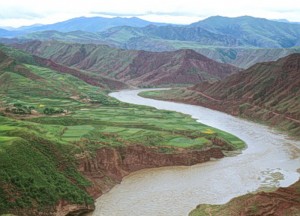- The Yellow River is the second longest river in China after the Yangtze River, and the sixth longest in the world. Originating on the Qinhai-Tibetan plateau in western China, it runs for some 5,500 km across the vast North China Plain, traversing nine provinces before draining into the Bo Hai Sea.
- Its catchment area of 795,000 km2 is home to 110 million people (2000) or about 8.7% of China’s population. (The figures increase to 189 million and 14.9% if the flood plain surrounding the lower reach is included.) In 2000, about 26.4% of the basin was urbanized.
- More than 60% of the annual precipitation falls between June and September, during the crop-growing season. Average rainfall recorded during 1956–2000 was 454 mm over the entire basin, the lowest level being in the upper reach (372 mm) and the highest in the lower reach (671 mm).
- Average total renewable water resources for 1956–2000 were estimated at 66.1 billion m3, including 17.2 billion m3 of groundwater. However, in 2000, the total available water supply was around 48.4 billion m3. Water demand in the basin sharply increased from 10 billion m3 in 1949 to 37.5 billion m3 in 2006.
Groundwater has been extensively exploited in the basin since the introduction of the tube well in the late 1950s. In 2000, groundwater abstraction reached 10.7 billion m3 and there were some 380,000 tube wells in the basin. - The biggest direct impact of a booming economy coupled with rapid industrialization and population growth was on water quality. For example, the amount of untreated industrial sewage being dumped into the Yellow River has doubled since the 1980s to 4.2 billion m3 per year. The river receives over 300 pollutants, and only about 60% of its course is now fit for drinking water supply.
- In 2000, there were over 10,000 reservoirs in operation, with total storage capacity of 62 billion m3; 23 involve large dams. Hydropower production in the basin amounts to 40 TWh per year.
The expansion of irrigation in the basin has been rapid. The irrigated area rose from 8,000 km2 in 1950 to 75,000 km2 in 2000. Demand for irrigation water grew steadily, reaching 38.1 billion m3 in 2000.
The section “Did You Know…?” is taken from the 3rd World Water Development Report “Water in a Changing World“.


